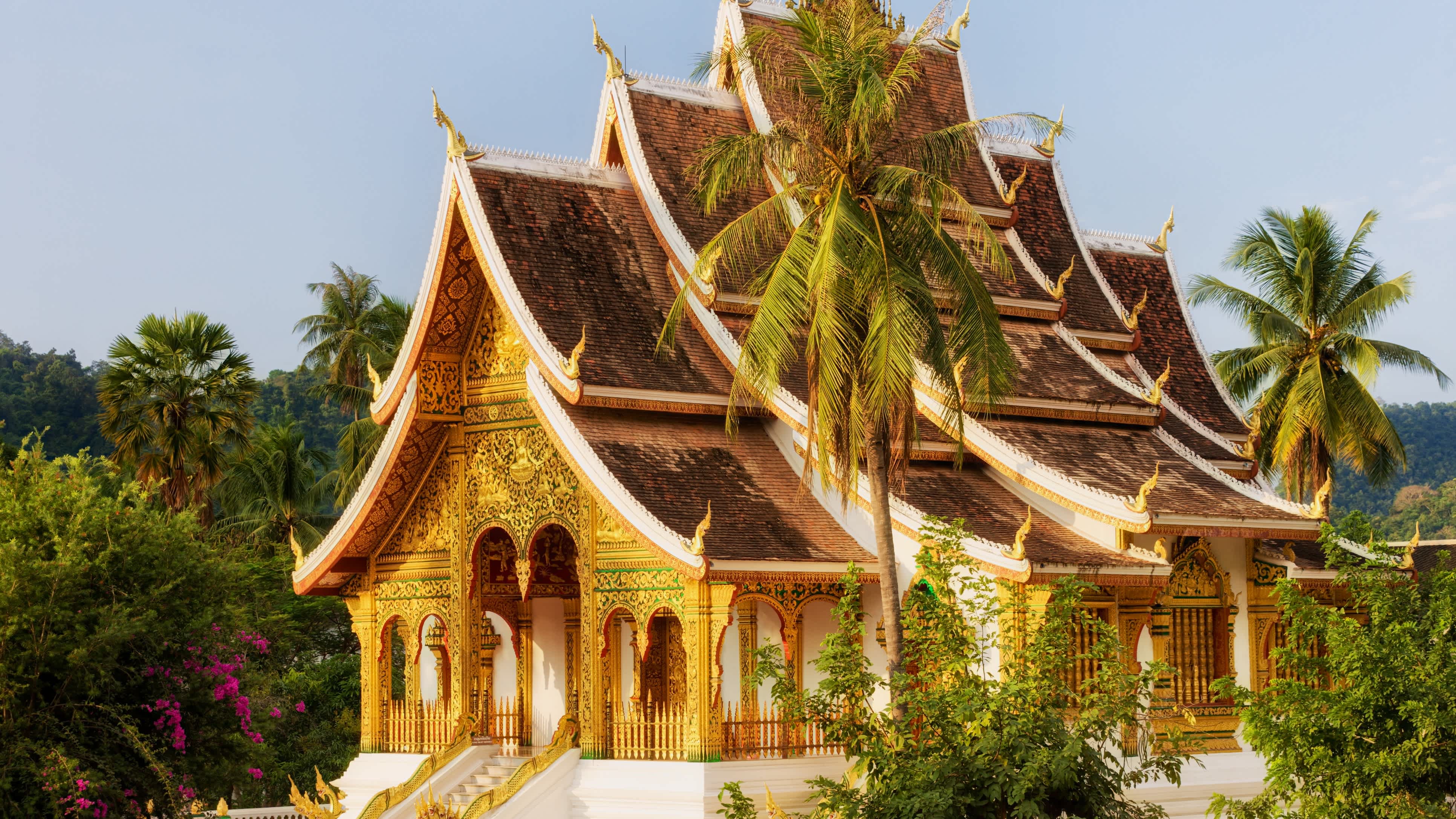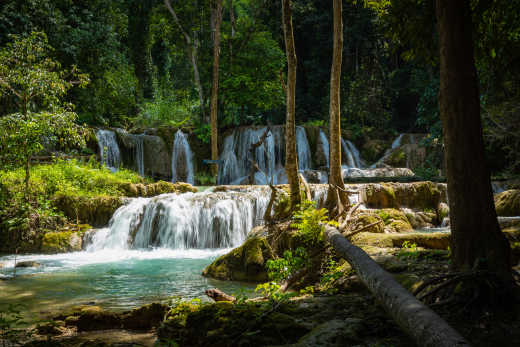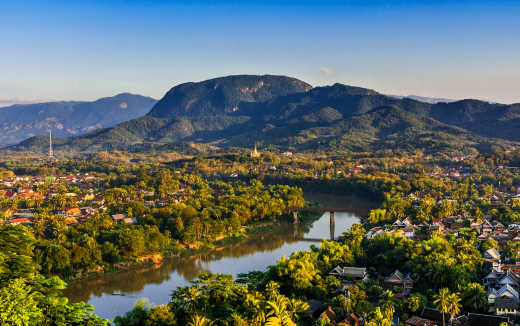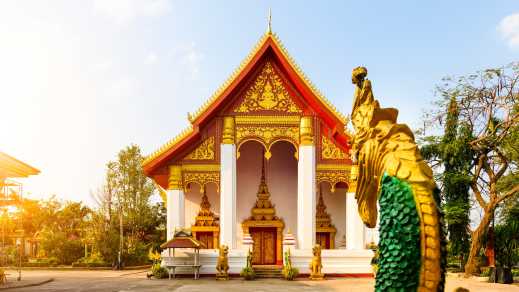
Luang Prabang Tours
The top sights, highlights, tours & travel itinaries curated by our Travel Experts.
- Destinations
- Asia
- Laos
- Luang Prabang
Our Expert Tips for Your Luang Prabang Tour
The ancient Laotian royal city of Luang Prabang is said to be one of the most beautiful places in all of Southeast Asia. The golden stupa of Wat Chom Si, rising venerably from the forests of Mount Phousi, points the way from afar. Wat Mai, in the heart of the temple town, is still fully preserved and exudes a noble and spiritual aura.
At almost every corner in Luang Prabang, you will be immersed in the Buddhist life of the Laotians. The royal city on the Mekong is relaxed and friendly. Just sit down at one of the lotus ponds and watch the colourful hustle and bustle. Less
![Asia Loas Luang Prabang Wat Xieng Thong Luang Prabang Wat Xieng Thong]()
Wat Xieng Thong
The oldest temple complex in Luang Prabang
![Asia Laos Luang Pabang Tat Sae Waterfalls Luang Pabang Tat Sae Waterfalls]()
Tat Sae Waterfalls
A refreshing experience
![Asia Laos Luang Prabang Mount Phousi Luang Prabang Mount Phousi]()
Mount Phousi
For a great panoramic view
What to See During Your Luang Prabang Tour?
1. Royal Palace of Luang Prabang
The Royal Palace of Luang Prabang was once designed so that visitors arriving by boat via the Mekong River could walk directly ashore and be welcomed into the palace via a staircase of Italian marble. Today, the palace of King Sisavang Vong, built in 1904, is used as a national museum. In a lovely mix of Lao architectural style and French Beaux-Arts, the complex looks extremely elegant and distinguished. In the museum, you may admire paintings from all over the world and ornate Buddha statues made of gold, silver, marble and ivory. In addition, the official crown jewels of Laos are also displayed in the royal palace. The palace includes other elaborately crafted buildings, a mighty statue of the late king, and romantic lotus ponds that are typical of Luang Prabang.
2. Wat Xieng Thong
Wat Xieng Thong is the oldest temple complex in Luang Prabang and is considered one of the most important Buddhist centers in Laos. The temples, halls and stupas unparalleled represent the masterful and exciting Luang Prabang architectural style. The overlapping roofs of the pagodas resemble the back scales of a dragon. Gold and intricate ornamentation give the buildings a spiritual aura. Wat Xieng Thong is located right on the bank where the Nam Khan flows into the Mekong. The name translates as "Monastery of the City of the Flame Tree". This goes back to the origin myth of Luang Prabang. You can experience the whole legend first hand in the spacious and idyllic grounds set amongst lush vegetation. The complex includes the ordination hall, the Ho Phra Mane library and the "red chapel". An unforgettable experience on your Luang Prabang trip.
3. Wat Mai Suwannaphumaham
Once you are in the center of Luang Prabang, visiting the Royal Palace and strolling in the night market, you will be magically attracted to Wat Mai Suwannaphumaham. It is the largest and most beautiful of all the temples you will marvel at in Luang Prabang. Its beauty is so extraordinary that Chinese troops spared only Wat Mai ("New Monastery") when they conquered Luang Prabang in the late 19th century. The fiery red roof tiles look like scale armor spanning the temple's porch and terraces. The elaborately gilded reliefs and decorations sparkle like a dream. They depict scenes from Buddhist mythology and take up themes from flora and fauna. Inside, countless Buddha statues line the rooms, mostly draped on altars and ornately crafted tables.
4. Wat Siphoutthabath
Away from the main sights of Luang Prabang is Wat Siphoutthabath. You can reach it via a steep staircase at the foot of Mount Phousi. Wat Siphoutthabath is mainly used as a monk school: The temple shines in the typical Luang Prabang style and is richly decorated. The representations enlighten you about Buddhism and the life of the believers. Although the condition of the temple - in contrast to Wat Mai - looks a bit battered, a visit is always worthwhile. Especially the evening hours are enchanting: Then you experience the evening prayers of the monks, who provide a spiritual soundscape with their singing. At the same time you look in the east on the mighty Mekong. A stirring experience that gives you authentic insights into the religious life of Luang Prabang.
5. Tat Sae Waterfalls
Whether following a city tour or in between to escape the midday heat; a visit to Tat Sae Waterfalls is not to be missed on your Luang Prabang trip. The cascading waterfall is located at Nam Khan, a few kilometers outside the temple town. It's best to take a tuk tuk or hop on a shuttle bus. Make your way through the woods via boardwalks until you reach the gushing cascades. The waterfalls plunge down in steps - always from one natural pool to the next. The water glows turquoise, is cool and refreshing. In the largest pool you can even take a dip and swim in paradisiacal surroundings. There are sanitary facilities, resting places, benches and a small restaurant here.
6. Mount Phousi
It is the holy mountain of Luang Prabang: Mount Phousi marks with 100 meters the peak on the historical peninsula. To the east, the mountain is bordered by the Nam Khan. Visitors usually climb Phousi for two different reasons: Either to pay their respects to the numerous Buddha statues and make offerings at Wat Chom Si on the summit, or simply to enjoy the spectacular 360° panorama over Luang Prabang and the Mekong River. No matter which route you take, you can expect at least 350 steps and 30 minutes of ascent. If you use the ascent on the side of Nam Khan, you will pass the "Footprint of the Buddha". At the top is Wat Chom Si with its 20-meter high gilded stupa. Less
Other Places to Visit During Your Tour
TourlaneCare





